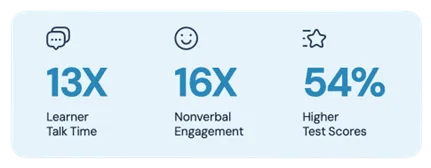ATD Blog
Build Better Training, Faster: 5 Active Learning Strategies That Work
Tue May 20 2025

Why active learning isn’t optional anymore.
You’ve put in the hours. The slide decks are polished, the training sessions are scheduled—and yet, a week later, nearly all of your content is forgotten. It’s not your employees’ fault. It’s a well-known phenomenon. Passive learning doesn’t stick.
Active learning is your remedy. Research shows it boosts retention, shortens time to proficiency, and increases training ROI. But there’s a catch: designing active learning experiences is very time-consuming. According to ATD and Chapman Alliance benchmarks, it can take 40–80 hours just to build the interactive components of a single hour of e-learning. Add in instructional design, content development, media production, testing, and project management, and the total climbs to 150–300 hours per hour of training.
That kind of time investment doesn’t scale, forcing you to compromise learning outcomes in order to keep pace with the demands of the business. But by rethinking how you design, deliver, and scale training—without starting from scratch—it becomes much more manageable. Here are five practical strategies to help you get started.
Figure: Impact of Active Learning Online

1. Repurpose and modularize what you already have
Most L&D teams are sitting on a treasure trove of great content: recorded webinars, internal presentations, live online trainings, written articles. There’s nothing wrong with the content per se, it’s just delivered in a way that isn’t easily retained. So don’t start from scratch. Start by identifying what can be reused.
Then, break content into short, standalone modules. Microlearning not only accelerates production and personalization, but it also fits better into the real flow of work.
Try this:
Audit your existing content library (videos, decks, job aids).
Cut long videos into short clips organized by task or goal.
Add light interaction: “pause and reflect” prompts, checklists, decision points, or scenario-based questions.
2. Add just enough interaction, strategically
You don’t need a full gamified simulation to make training active. The best interactions are the ones that match the moment: a poll at a decision point, a prompt that asks for real-world application of a concept, or a quick quiz that checks understanding.
Try this:
Identify natural “decision moments” in your training content.
Add interaction where a learner would benefit from reflection or practice.
Keep it lightweight by focusing on meaningful over flashy.
3. Let AI do the heavy lifting
One of the fastest wins for L&D teams is offloading the manual, time-consuming parts of course creation. AI-powered tools like Engageli Studio can instantly add interactivity to uploaded videos, streamlining the process of creating active training content. The platform auto-chunks video into lessons, inserts quizzes and activities, and gives insight into engagement and completion, all with just a few clicks.
Try this:
Identify high-use but low-interactivity content to pilot with AI tools.
Use AI to generate the first draft, then fine-tune to match your learning goals.
Focus your team’s time on design, feedback, and strategic alignment.
4. Let your learners create the content
Empower your employees to create bite-sized, peer-to-peer training. It’s authentic, scalable, and often more relevant than top-down content.
Launch a simple challenge, like “Show Us How You Do It”, where employees share how they solve real problems they encounter in their role. Then, curate and lightly enhance the best clips into an internal learning library.
Try this:
Ask a few power users or top performers to create a 5-minute “how-to” recording.
Use AI tools to add structure and interaction to those clips.
Organize by workflow (for example, “Closing a Deal,” “Handling Difficult Customers,” and the like).
5. Use data to iterate instead of guess
Looking for a faster, more targeted way to improve your training content? Start with data. Instead of relying solely on anecdotal input, track key signals like drop-off points, quiz scores, and replay rates to improve content over time.
Try this:
Define 1–2 measurable outcomes per course (such as completion, application on the job, quiz scores).
Use platform data to identify friction points or content gaps.
Adjust content monthly (not annually) to keep learning fresh and relevant.
Training That Has an Impact
In corporate L&D, the goal is to help people do better work and build skills they can actually use. Active learning is one of the most effective ways to get there. And with smart strategies and the right AI tools in your corner, it can be scalable too.
Even in high-pressure environments, small changes in how we design and deliver training can lead to real, measurable impact. Now’s the time to experiment, test new strategies, and find what works best for your learners.
Explore the instructional design process from start to finish in ATD's Instructional Design Certificate.

